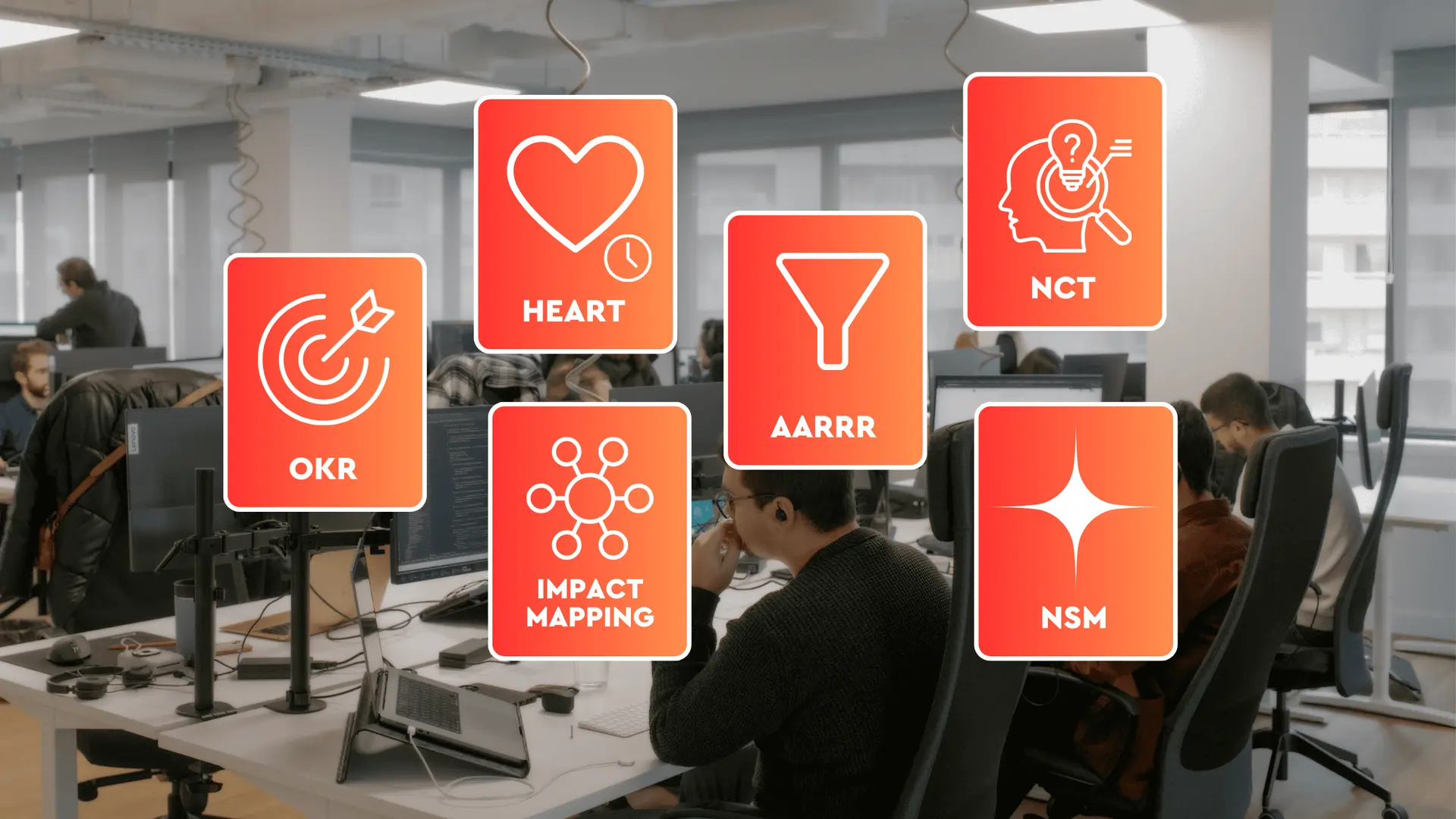May 5, 2025 - 10 minutes read

AUTHOR

Sybren van Putten
Sr. Product Consultant
Steer product development with the right goal-setting framework
In our recent article on the use of metrics, Connecting Product Effort to Business Success we highlighted the importance of measuring the impact of product development. Knowing if your efforts generate results is crucial, but measurement alone doesn't set the course. Especially in SaaS (software-as-a-service), where consistent value creation is key, a proactive approach to steering is key.
SaaS product teams must ensure that development effort consistently leads to measurable business results and genuine customer value. Among our clients, I see this as one of the main challenges these companies face. Strategy is often in place, although formalization and articulation leave room for improvement. However, strategy alone does not resonate in your operational teams. The answer to this challenge lies, for a large part at least, in strategically guiding the team’s efforts by setting clear goals, aligned with strategy, and consistently tracking progress toward achieving them. Here, goal-setting frameworks are of great help. These frameworks act as navigation tools, providing out-of-the-box structure, focus, and alignment, helping you translate abstract strategies into actionable plans that, unlike strategy only, do resonate in the operation. They define success and help prioritize what needs to happen to achieve it.
This article explores several goal-setting frameworks that are commonly used in SaaS Product Management: OKR, North Star Metric, HEART, AARRR Pirate Metrics , Impact Mapping, and NCT. Each offers a unique lens, but all aim for the same goal: to stimulate targeted effort. Selecting and implementing them effectively, however, requires careful consideration and often a great deal of guidance - a nod to the complexity where expertise truly matters.
Why goal-setting frameworks are essential to SaaS success
The unique context of a SaaS product team makes structured goal-setting a necessity, not a luxury. This dynamic stems from its subscription-based model, where customer retention is as crucial as acquisition, demanding alignment across teams and frequent updates and improvements. Unlike the traditional software’s focus on projects and one-time sales, SaaS product teams thrive when continuously delivering value to retain and expand customers.
- Retention is king: Keeping customers is absolutely essential for a subscription model to remain sustainable, even if it's just to maintain a healthy CLTV/CAC ratio. Focusing on user happiness and engagement, frameworks like HEART and AARRR provide retention-centered approaches.
- Continuous delivery and iteration: Your customers and potential customers expect constant improvement. Frameworks like OKR and NCT, with regular evaluation cycles, support this iterative nature and align well with the Agile approaches to iterating.
- Product-led growth: Many SaaS companies, particularly scale-ups, rely on the product itself to grow their business. The North Star Metric (focusing on core product value) and AARRR (optimizing the in-product user journeys) are vital here.
Goal-setting also shapes team culture. The trend is shifting focus from the delivery of features (output) to the achievement of results (outcomes). This cultural shift has a significant impact on SaaS success, and choosing the proper framework will support your organization in adopting this new mindset.
So, in essence, these frameworks bridge the gap between high-level company vision and strategy and the product team's daily tasks. They prevent siloed efforts and the development of features disconnected from business objectives (a pitfall that I observed occurring at many of my clients, all with limited goal-setting practices). Without a framework, SaaS development often becomes reactive and misaligned, ultimately hindering growth and wasting already limited resources.
A tour of goal-setting frameworks
Let's examine the most relevant frameworks for SaaS product management.
OKR (Objectives and Key Results) framework
A popular goal-setting method developed by Intel and Google that encourages (stretch) goals using ambitious objectives (the what) and 3-5 measurable Key Results (the how). Transparency and regular check-ins are vital.
- SaaS relevance: Perfect for aligning cross-functional teams around shared outcomes such as MRR growth, churn reduction, etc. Fits well with quarterly SaaS cycles.
- Pros and cons: Strong on alignment, focus, ambition, accountability. Can be time-consuming, key results easily become task lists, and sometimes lacks the strategic why
- Example:
- Objective: Improve user onboarding.
- KR1: Reduce trial abandonment from 40% to 30%.
- KR2: Increase key feature X completion from 70% to 80%.
- KR3: Improve trial-to-paid conversion from 20% to 30%.
North Star Metric framework
The NSM framework defines your product’s true north by focusing on the North Star Metric; the single metric best representing customer value. A good NSM not only reflects customer value, but also predicts business success (leading indicator) and is influenceable. The framework adds 3 to 5 directly influenceable inputs that drive the NSM.
- SaaS relevance: Powerful for product-led growth companies. Focuses the organization on optimizing core user value, driving retention and long-term growth. Links product activity, customer value, and business success.
- Pros and cons: Provides laser-focus, alignment and data-driven prioritization. Finding the right metric can be hard and requires solid analytics.
- Examples: Nights Booked (Airbnb’s NSM) or Daily Messages Sent (Slack’s NSM)
HEART framework
The HEART framework was developed by Google UX researchers to measure and improve user experience quality across five dimensions, for a holistic UX view: Happiness, Engagement, Adoption, Retention and Task success.
- SaaS relevance: Essential for SaaS as positive UX impacts engagement, retention, and CLV. Helps quantify the soft UX aspects and link them to business results.
- Pros and cons: Strong focus on the user, prioritized UX. Requires data infrastructure, defining clear signals/metrics can be tricky and potential category overlap.
- Examples:
- Happiness: NPS, surveys
- Engagement: frequency, time in app
- Adoption: activation rate, feature use
- Retention: churn, return rate
- Task success: completion rate, errors
Pirate Metrics (AARRR) framework
The AARRR framework focuses on five customer lifecycle stages: Acquisition, Activation, Retention, Referral, and Revenue. By tracking users through a sequential funnel, focused on measurable conversion metrics per stage, it helps optimize the growth funnel.
- SaaS relevance: This framework is directly tied to the SaaS customer journey and supports scalable growth by identifying bottlenecks and optimizing conversion rates at each stage.
- Pros and cons: Clear funnel insight, bottleneck identification, data-driven optimization, actionable metrics. May be too linear, there’s a risk of optimizing stages in isolation, less focus on overall UX or strategy.
- Examples:
- Acquisition: signups, CAC
- Activation: onboarding completion, free-to-paid conversion
- Retention: churn, CLV
- Referral: invites sent, referral conversion
- Revenue: MRR, ARPU
Impact Mapping
Impact Mapping is a visual planning technique (rather than a framework) that connects goals (the what) to actors (who), desired impacts (behavior changes / how), and deliverables (features or the what). By doing so, it ultimately connects features to goals and ensures they contribute to achieving them. Note that it focuses on outcomes rather than outputs.
- SaaS relevance: Helps avoid the 'build trap' by linking features to strategy. Useful for prioritizing in complex SaaS products and communicating rationale. Supports discovery and roadmapping.
- Pros and cons: Strong goal alignment, prevents scope creep, aids prioritization, improves communication. Based on assumptions needing validation, it can be time-consuming.
- Example:
- Goal: Increase onboarding completion to 20%
- Actor: Prospective users
- Impact: Complete first order
- Deliverable: Simplified checkout
- Actor: Customer Success
- Impact: Proactively support stuck users
- Deliverable: Onboarding status dashboard
NCT framework
NCT (Narrative, Commitments, Tasks) is a modern framework emphasizing and starting with strategic context (the narrative) alongside measurable commitments and action-oriented tasks, in a quarterly cadence. Effectively addresses perceived OKR shortcomings.
- SaaS relevance: NCT is very useful for ambiguous projects, new products, or where deep strategic context is vital. It offers flexibility and connects daily tasks to strategy. Supports agile adaptation.
- Pros and cons: Strong strategic context, clear strategy-task link, flexible commitments (tasks). Newer framework, good narratives require significant effort, potential task-list focus if mismanaged.
- Example:
- Narrative: Launch new version with latest tech to attract users & improve performance.
- Commitments:
- Launch beta by end of Q
- Increase user base 10k to 15k
- Tasks:
- Develop marketing campaign
- Collect beta feedback
While you should never introduce complexity from the start and therefore begin lean and small, these frameworks often work best in combination. For example: a team may use OKRs for high-level goals, AARRR to diagnose a funnel issue within a key result and HEART to evaluate the UX impact of the solution.
Choosing the right framework
There's no single best framework. The optimal choice depends on the - often unique - dynamic of your organization. This also implies that switching to another framework may be beneficial when your organization matures and its context changes. So far, we haven’t seen dogmatic adherence pay off.
Instead, you should consider at least these six factors:
- Company stage & size
- Consider whether your organization is a startup needing rapid growth optimization and flexibility, or larger, requiring strong alignment across multiple teams. The scale and phase of your business influence the type of structure and focus needed.
- Team maturity
- Evaluate your team's experience with structured goal-setting and their capacity for handling ambitious targets versus needing more context and guidance.
- Strategic focus
- Identify your primary strategic priority at this moment. Is the main challenge optimizing the customer journey and conversion funnel? Is it enhancing the overall user experience and satisfaction? Or is the priority translating high-level strategy into concrete features and avoiding the 'build trap'? This main challenge dictates the perspective from which goals should be viewed.
- Organizational culture
- The framework(s) you choose should resonate with how your organization operates. Assess your company's cultural appetite for:
- ambition and its ability to handle potential failure versus deterministic goals
- deep strategic context versus straightforward execution
- reliance on data-driven decision-making versus gut-feeling
- Measurement capability
- Having a framework in place does not necessarily mean that goals can be tracked accurately. Your data capabilities will enable or constrain certain approaches. Determine your ability to track and analyze the metrics required by the frameworks reliably. Can you really measure detailed user interactions, funnel conversions, user sentiment, or complex value calculations?
- Complexity and overhead tolerance
- Consider the level of effort your organization is willing to invest in setting up, maintaining, and coaching teams on the use of a new framework. Some methods are lightweight and intuitive, while others demand more rigorous processes, tooling, and ongoing management.
The selection process itself forces valuable strategic discussion. It's not a one-off choice; regularly evaluate your framework's suitability to avoid blind spots.
Summarizing comparison of Goal-Setting Frameworks
| Framework | Focus | Metric Type | Cadence | Best for | Complexity |
| OKR | Alignment, Focus, Ambitious goals | Qualitative Objectives, Quantitative KRs | Quarterly | Aligning cross-functional teams and driving specific measurable results | Medium |
| North Star Metric | Value delivery, Long-term growth | One leading metric (NSM), Input metrics | Continuous | Product-led growth companies, Focus on the core growth engine, Strategic focus on customer value | High |
| HEART | User Experience quality | Qualitative & Quantitative UX metrics | Continuous / project | Improving product UX, Linking UX to retention/satisfaction, Data-driven UX design | Medium- High |
| Pirate Metrics / AARRR | Growth Funnel Optimization | Conversion metrics per phase | Continuous / weekly | Startups, PLG, Identifying & solving conversion bottlenecks, Growth hacking | Low-medium |
| Impact Mapping | Strategy to feature alignment, Outcome-focus | No direct metrics | Project / initiatief | Preventing the build-trap, Stakeholder communication, Product discovery | Medium |
| NCT | Strategic Context (the why), Flexible execution | Narratives, Commitments (metrics/deliverables) | Quarterly | Ambiguous projects, 0-1 products, Teams needing deep context, OKR alternative | Medium |
As you ponder about Product and explore the potential within your product management practices, remember that you're not navigating these waters alone. We, the 25Friday team, are dedicated to guiding tech companies through the maze of product strategy. With our expertise in consultancy and nearshore development, we partner with organisations to fine-tune their product vision, align their teams, and craft strategies that resonate in today’s dynamic market. Reach out to us, and let's work together to turn your product challenges into successful ventures that stand out in the tech landscape.
Choose Product Goal Framework
Product Strategy Alignment
Improve SaaS User Retention
Drive SaaS Business Results
AARRR Pirate Metrics
North Star Metric SaaS
OKR for SaaS Products
SaaS Product Management Goals
Steer Product Development
SaaS Goal Setting Frameworks
Related posts

Product Management
March 20, 2025
-
5 min read
Connecting Product Effort to Business Success
As a product manager in a SaaS scale-up, you’re constantly shipping features, improving user experience, and optimizing workflows. But how often do you step back and ask: is this actually moving the business forward?
As a Product Management consultant, I often find product teams celebrate launches as if shipping features is the goal. But releasing stuff is different from making an impact. Without a clear connection between product effort and business success, teams risk prioritizing the wrong initiatives, struggling to get stakeholder buy-in, and ultimately becoming a cost center rather than the company’s driver of growth.

Sybren van Putten
Sr. Product Consultant

Product Management
January 2, 2025
-
3 min read
Bridging the gap between Product and Sales in SaaS Companies
Many SaaS businesses deal with an often challenging partnership: the collaboration between their product and sales teams. This dynamic was the topic of an event we hosted earlier this year: “Product & Sales: A Winning Partnership?”, where we gathered product management professionals and sales representatives to exchange insights and strategies for stronger collaboration and overcoming friction. The discussions illuminated the obstacles and opportunities in aligning these two functions, offering a roadmap for achieving shared success. In this blog, we provide you with the 5 key takeaways.

Sybren van Putten
Sr. Product Consultant